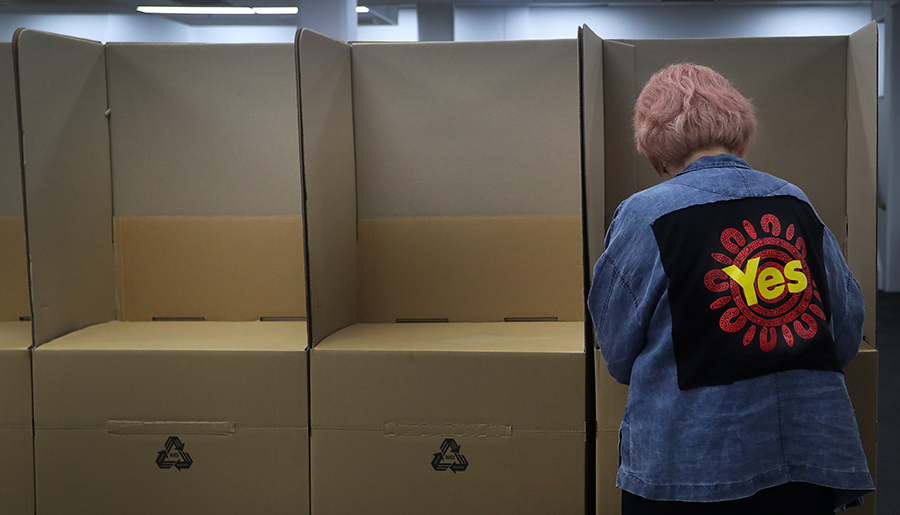What is the Voice to Parliament?
Tomorrow, Australia will cast a historic vote. The results of which will impact the lives of First Nations people for generations to come. However, if you were to ask every voter to explain what the Voice to Parliament would is, a whack of them wouldn’t be able to give you an answer.
Unfortunately, over the last few years, the Voice to Parliament debate has become a swill of misinformation. Take for instance Fair Australia’s No campaign. This organisation has been telling voters that the architects of the Voice were “campaigning to abolish Australia Day.” This is a fabrication that murkies the debate.
So, with all of this info in mind, let’s set the record straight. Let’s unpack every Voice to Parliament detail that you need to know. That way, when the referendum rolls around, you can make an informed decision.
Here we go.
What is a First Nations Voice to Parliament?
A First Nations Voice to Parliament is a group of 24 First Nations people that will advise the Federal Government on First Nations issues. Yup. That’s literally it.
The Federal Government’s Constitutional Expert Group has recommended that the following paragraph be added to our constitution.
In recognition of Aboriginal and Torres Strait Islander Peoples as the First Peoples of Australia:
- There shall be a body, to be called the Aboriginal and Torres Strait Islander Voice.
- The Aboriginal and Torres Strait Islander Voice may make representations to Parliament and the Executive Government on matters relating to Aboriginal and Torres Strait Islander Peoples.
- The Parliament shall, subject to this Constitution, have power to make laws with respect to the composition, functions, powers, and procedures of the Aboriginal and Torres Strait Islander Voice.
According to Megan Davis, a member of said Constitutional Expert Group, the powers of the Voice have been greatly exaggerated.
As this proud Cobble Cobble woman told The Latch, “The Voice will not be a third chamber of Parliament. We have addressed this many times since the Turnbull Government first made the claim back in 2017.”
“The Voice will advise our government of the day on matters concerning the lives of First Nations Peoples. It will not have any hidden powers or veto abilities.”
In a speech made by the Minister for Indigenous Australians, Linda Burney, she noted what the Voice’s priorities might be.
“I will ask the Voice to consider four main priority areas,” said Burney, “Health, education, jobs, and housing.”
“Unlike government, it won’t be distracted by the three-year election cycles. It will plan for the next generation, not the next term.”
How Will the Voice Be Organised?
The Voice will have two levels. The first level will be a National Voice. The second level will be a series of Local and Regional Voices.
The National Voice
The National Voice will consist of 24 members:
- Two members from each state and territory.
- Five members from regional Australia.
- Two members from Torres Strait.
- One member representing Torres Strait Islanders on the mainland.
On the national side, there will additionally be an equal number of male and female members. Each member will serve either a single four year-term or two terms, that being eight years in total.
These individuals will be members of one or two permanent advisory groups. One group being disability and the other being youth issues. There will also be a small ethics council that will advise the government on moral issues.
The Local and Regional Voices
The Local and Regional Voices will consist of 35 members. These 35 members will represent 35 different Aboriginal and Torres Strait Islander communities from different areas.
Each of these Voices’ responsibilities will be individually tailored. This will be so they can support their representatives to the best of their availability. After all, Aboriginal and Torres Strait Islander community is super unique. So a one-size-fits-all approach just wouldn’t work here.
However, we do know that these Local and Regional Voices won’t be advising just the Federal Government. They’ll be advising every level of government, non-government sectors, and businesses.
It’s also worth noting that these Local and Regional Voices would have a direct line of communication with their National Voice counterparts.
What is the Voice to Parliament Referendum?
On Saturday, October 14, every enrolled Australian will vote if they are in favour of a Voice to Parliament being enshrined in our Constitution. Well, every enrolled Australian that hasn’t voted early, that is.
This group of individuals will be asked to answer the following single “yes” or “no” question.
“A Proposed Law to alter the Constitution to recognise the First Peoples of Australia by establishing an Aboriginal and Torres Strait Islander Voice. Do you approve this proposed alteration?”
According to the Electoral Commissioner, Tom Rogers, all eligible Aussies aged 18 years and over are required by law to vote in this referendum. What’s more, if you don’t, you might receive a fine.
“If Australians are unsure of the status of their enrolment, they should jump on the AEC website now and make sure their details are up to date,” Rogers said.
“Any federal referendum is a significant moment for the country… If you are not enrolled, you will not be able to participate.”
If you want to check your voting status, click the link here.
Related: Will You Score a Democracy Sausage This Saturday?
Related: Could a Voice to Parliament Help Save Our Environment?
Read more stories from The Latch and subscribe to our email newsletter.







